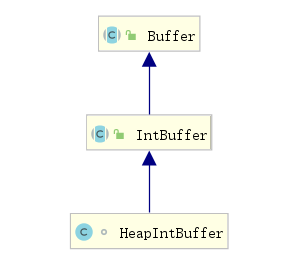简介
IntBuffer 是 Int 的缓冲区类型
类的关系图如下:

- Buffer:抽象类,一切Buffer相关的基类
- IntBuffer:抽象类,内部维护一个 int[ ] 的数组对象
- HeapIntBufferr:IntBuffer 的实现类,封装了对上一步 int[ ] 的操作方法
公共属性
// Invariants: mark <= position <= limit <= capacity
private int mark = -1;
private int position = 0;
private int limit;
private int capacity;
初始化
示例:分配一个容量大小为5的 IntBuffer 对象
IntBuffer intBuffer = IntBuffer.allocate(5);
底层源码:
- 实际上调用的是 HeapIntBuffer 的构造函数
//IntBuffer#allocate
public static IntBuffer allocate(int capacity) {
if (capacity < 0)
throw new IllegalArgumentException();
return new HeapIntBuffer(capacity, capacity);
}
HeapIntBuffer 构造函数:
- 初始化 mark = -1,position = 0,limit = 5,capacity = 5
- 初始化 IntBuffer 自带的属性 offset = 0
- 初始化 int 数组大小为 5

添加数据
示例:添加数据1、 3、 5、 7、 9
intBuffer.put(1);
intBuffer.put(3);
intBuffer.put(5);
intBuffer.put(7);
intBuffer.put(9);
put 源码:
//HeapIntBuffer#put
public IntBuffer put(int x) {
hb[ix(nextPutIndex())] = x;
return this;
}
nextPutIndex:判断 position 超出 limit 大小就抛出异常,否则返回当前 position,并网上加1作为下次使用
//Buffer#nextPutIndex
final int nextPutIndex() {
// package-private
if (position >= limit)
throw new BufferOverflowException();
return position++;
}
ix 函数:实际就是 position 的值加上偏移量 offset(上一步已讲过,该值为0)
//HeapIntBuffer#ix
protected int ix(int i) {
return i + offset;
}
执行5次 put 操作之后,此时 position = 5,limit = 5
读取数据
注意:Buffer 类进行读操作,必须先调用 flip() 反转缓冲区
intBuffer.flip();
while (intBuffer.hasRemaining()){
System.out.println(intBuffer.get());
}
flip() 函数源码:
- 把 limit 的值设为当前 position 的值
- 把 position 的值设 0
public final Buffer flip() {
limit = position;
position = 0;
mark = -1;
return this;
}
- 效果如下图所示:反转后操作的就是已经 put() 的数据

hasRemaining() 判断是否还有值:
//Buffer#hasRemaining
public final boolean hasRemaining() {
return position < limit;
}
get() 获取当前数据:
- 取出当前 position 位置的数据,并对 position+1
public int get() {
return hb[ix(nextGetIndex())];
}
问题来了:flip() 反转后,如果要继续对 IntBuffer 追加数据,该怎么办?
通过上面的示例图,可以看出来。如果要继续追加新数据,需要修改相关索引值:
- 把 position 设置为 limit 的值
- 把 limit 的值设置为 capacity 的值
附上一个完整的例子:
public class test {
public static void main(String[] args) {
//初始化容量大小为5
IntBuffer intBuffer = IntBuffer.allocate(5);
//追加2个数据
intBuffer.put(1);
intBuffer.put(3);
//反转置换
intBuffer.flip();
System.out.println(intBuffer.get());
System.out.println(intBuffer.get());
System.out.println("----------------------------");
//重新设置position
intBuffer.position(intBuffer.limit());
intBuffer.limit(intBuffer.capacity());
//继续追加数据
intBuffer.put(20);
intBuffer.put(21);
intBuffer.put(22);
//再次反转置换,然后全部输出
intBuffer.flip();
while (intBuffer.hasRemaining()){
System.out.println(intBuffer.get());
}
}
}
输出结果:
1
3
----------------------------
1
3
20
21
22